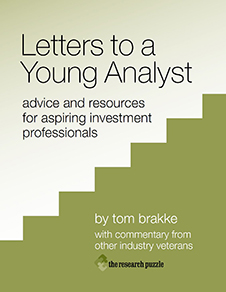
- Tuesday, April 28th, 2015
- look in the fridge
-
Last week, I posed this question on Twitter: “I’m in the midst of doing some independent reviews of asset managers (where I have full access); what would you look for at yours?”Twitter | Most of my tweeting involves providing links to interesting reading from around the investment ecosystem.
There were a few responses, including ones about the need to understand the interplay of narrative and events, and the worth (or lack thereof) of onsite due diligence. Then, a person who tweets under the name Unrelated Nonsense replied by saying, “Look in the fridge.”Twitter | Here is that response.
I got a chuckle out of that. I assume that others who have witnessed the surprises and mysteries inside refrigerators in the kitchens of organizations did too. But, in addition to being funny, the tweet served as a metaphor for the craft of due diligence: you need to seek out that which is hidden. No one is going to show you the inside of the refrigerator, and very few will ever freely reveal the things that are sub-par in an organization.
Throughout the process of vetting an asset manager (or any other organization being evaluated, but let’s use that as the example), most of the communication is scripted in one way or another.
Certainly a request for proposal (RFP) or a due diligence questionnaire (DDQ) is that way by design, with the answers that are provided serving as a baseline of information for the issuer of the RFP or DDQ, allowing it to compare responses across potential providers. In addition, those documents give a respondent the opportunity to define itself precisely, to frame its story in advance of further interactions.
If you are assigned to do due diligence during the next leg of investigation, your main responsibility is to pull that story apart and examine it from every reasonable angle. Let’s say you have the opportunity to do an onsite visit. If it begins with you being led through a PowerPoint presentation or a hard-copy pitch book, you’re likely about to waste a bunch of time without gaining any ground. The manager’s purpose is to strengthen the frame that’s already been established, and if you have done your work in advance, the encounter will be a rehash of what you already know.
From there, the quality and nature of your questions will determine whether you get very far beyond that base level of knowledge. The manager will have canned responses to most of them. If the people you interview don’t hesitate in response to any of your inquiries, or seem befuddled by them, or say, “We’ve never had that question before,” you’re probably not being aggressive enough in exploring the nooks and crannies of the organization and how it operates.
You want to look inside that metaphorical refrigerator, with its surprises and mysteries. Every organization is made up of that which you can see, that which you think you can see (but can’t), and that which you are very unlikely to see without a lot of effort (and often not even then). Discoveries come from breaking out of the standard methods of approach or asking the questions that aren’t asked by everyone else who comes to visit. Due diligence should not be predictable; it should not follow a well-worn path.
When in doubt, remember: Look in the fridge, wherever it may be.
